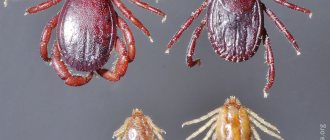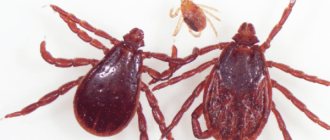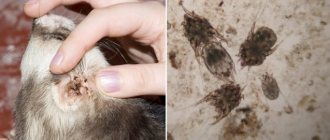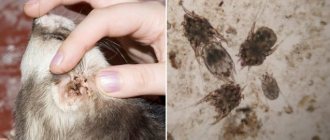Springtime brings with it a charge of positive emotions; nature awakens in all its diversity, including the world of insects. Not all of them are friendly to humans, and some are quite dangerous. Some of them are not easy to get rid of. For example, you need to know exactly how to remove a tick and not harm your health or the well-being of a loved one who has become the target of the parasite’s aggression. There are several proven methods for removing the pest. It is better not to touch it with your fingers, but to use special devices for removing them, which can easily fit in a pocket or small compartment of a backpack.
If you need quick and effective treatment of an area against ticks, we recommend contacting EcoSept!
Why are ticks dangerous for dogs?
These parasites feed on blood. To do this, they have a specially shaped mouthparts - with a proboscis and hook-shaped spines. With these spines, the insect pierces the dog's skin and is held there, and with its proboscis it sucks out the blood. During a bite, the parasite injects a secretion that reduces pain. This saliva may contain microorganisms that cause serious illnesses: ehrlichiosis, borreliosis or Lyme disease, babesiosis or piroplasmosis. All these diseases are severe and cannot be cured at home. At the first symptoms, be sure to contact your veterinarian.
Regardless of whether a tick is a carrier of pathogenic bacteria, it should not be left on the dog’s body:
- It will disturb the animal.
- It can go deep under the skin and cause inflammation, like a foreign body.
- A tick that has drunk blood is easy to crush. If it is infected, the infection can spread not only to the animal, but also to the owner.
Signs of a bite and why it is dangerous
Blood-sucking insects of the parasitic type are very leisurely; they know that as soon as contact is found with the carrier, the percentage that they will not be able to bite is negligible. Protective coloring and small size make the pest almost invisible on dark and colorful clothing. From the moment of preparation to direct attachment to the skin, it can take about 20 minutes.
At the stage of blood sucking, anticoagulants enter the host tissue, preventing the process of blood clotting and the parasite can feed for a long time. They act like a pain reliever and the person does not feel discomfort. Removing a tick at the initial stage, before the bite, is possible with care and a certain amount of luck. Even while the ectoparasite is feeding, it can only be noticed visually upon careful examination.
Only when digestive enzymes of saliva are injected into the wound and partial dissolution of the surrounding tissue begins, local inflammation develops, itching, a burning sensation appears, and the temperature may rise. Externally, this is expressed in redness, swelling, and compaction, which can be easily felt with your fingers.
The danger lies not in the bite itself, but in the saliva of the pest, along with which the pathogens of Lyme disease and tick-borne encephalitis can penetrate. They are severe and can lead to disability. The most dangerous are ixodid forest ticks and the meadow variety.
When and where to look for ticks in fur
In summer and autumn, when parasites are active, you need to examine your dog after every walk.
Short-haired dogs are especially susceptible to ticks, but long, dense hair will not protect against parasites. They just choose areas where the fur is a little shorter. This could be: the muzzle, ears, belly and groin, paws, especially between the toes, next to the pads.
The pet's body must be carefully examined as a whole, without missing individual areas. You can use a comb to part the fur and look as close to the skin as possible. To detect the smallest tick that has not yet had time to suck blood, you can take a magnifying glass.
Symptoms of a tick presence
Having caught on the animal’s fur, the tick does not immediately dig into the skin, but moves around the body for some time in search of a suitable place.
The tick bite is painless, the parasite does not cause any discomfort to the dog and is difficult to notice under a thick layer of fur. Therefore, in the warm season, your pet should be carefully examined after each walk. Parasites like to occupy places where capillaries are located close to the skin, these are:
- muzzle;
- stomach;
- ears;
- neck;
- breast;
- the inner sides of the front and hind legs;
- groin area.
The insect penetrates the body slowly but deeply. Without changing its position, the tick can suck blood for several days, after which it falls off or changes location.
How to rid a dog of a parasite
To remove a tick you need to prepare:
- wash and disinfect your hands, wear sterile or disinfected gloves;
- calm and secure the dog, it is advisable to wear a muzzle, even if the pet is very peaceful: no one knows how the animal will behave in a stressful and painful situation;
- It is advisable to carefully trim the hair at the site of the bite;
- prepare an antiseptic for treating the wound.
If your dog is nervous, he may be feeling pain from the parasite. To soften it, you can treat the skin around the bite with lidocaine.
What not to do
Mistakes when extracting a dog from its skin involve inappropriate methods or incorrect actions.
On the left is a tick that has sucked blood, on the right is a hungry one
I consider the following methods unacceptable:
- Trying to remove it by hand. There is a high probability of the abdomen being torn off from the head, which remains in the wound and causes severe inflammation.
- Lubricating the spiracle with oil. Some dog breeders seriously believe that the tick will suffocate and fall off in about 20 minutes. An arthropod can go without air for a long time, up to a day. During this time, pathogenic microbes will definitely reach the salivary glands of the parasite from the intestines. In addition, the treated tick becomes slippery, making an attempt to remove it using a professional device very difficult.
- Insecticide treatment. The arthropod will definitely die, but it will not fall off immediately; it may remain in the skin. This threatens inflammation. Therefore, remove the tick anyway. The dying insect releases poisons that cause an allergic response in the dog.
- Using medical tweezers. If you don't have the skill, you will crush the tick's abdomen, or the head will remain at the attachment site. The contents will get on the skin, and if there are contaminants in it, they will enter the bloodstream through a bite wound or other skin defects.
- Prick with a hot needle. The parasite will die. If it has been attached for a long time, it will not fall off. And it’s easy to injure a dog or yourself. Manipulation causes inconvenience. Use a professional device.
- Harsh thread. Better not try. There is a high probability of the abdomen tearing off, the head will remain in the wound.
- Single-use syringe with cut cannula. Cover the parasite and create a vacuum with the movement of the piston. It doesn’t always work, it injures the skin.
- Treatment with alcohol or kerosene. Ineffective and may harm the dog.
- If the head remains after unsuccessful extraction, it should not be filled with iodine, burned with a cigarette, or picked out with a needle.
The use of professional devices does not insure you against the following errors:
- Pulling with a sharp upward movement leads to rupture of the arthropod.
- Working without rubber gloves is dangerous to your health. From the ruptured parasite, blood will flow with infectious agents that can penetrate through the pores of the skin.
- When pressing on the abdomen, the sucked blood containing contagium is injected into the pet's blood vessel.
- If, after removal, you forget to treat the wound with an antiseptic, you may become infected with microflora that constantly lives on the dog’s fur.
What not to do
To remove ticks from dogs, different methods are recommended. You can't just pull it out. There is a high probability that you will tear off the body of the tick, but the head will remain in the dog’s body. Removing one head is much more difficult at home. And if it is not removed, it will become a source of inflammation.
To remove ixodid ticks, some people advise pouring gasoline, oil, or other viscous or caustic liquids over them. This, of course, will kill the tick, but in agony it can go even deeper under the skin, secreting an increased amount of saliva with pathogenic bacteria. That is, it will only get worse.
You should also not remove a tick simply with your hands. In this case, you can not only tear the insect apart, leaving the head, moreover, when removed, the tick’s body, inflated with blood, will tear. If the tick is on the head, then infected blood can get on the mucous membrane in the mouth, nose, and eyes. It can get on wounds on the body of a dog or person. And because of this, the infection process will worsen.
So, you can’t pull out a tick:
- filling it with oil, gasoline, etc.;
- pulling it out in one motion;
- removing it by hand, without special tools.
The main task is to remove the entire tick without damaging it or leaving parts of it in the animal’s body.
Treatment of a pet at home
You should not self-medicate at home until a diagnosis is made. All medications and procedures must be prescribed by the attending physician after examination and tests.
Very often, the period of treatment and rehabilitation takes several months. The time depends on the type and nature of the disease, the selected therapy and the sequence of treatment. If you decide to treat your pet at home, you must follow the doctor’s recommendations and complete the full course. This is very important, since many diseases can “fall asleep” for a while, and then manifest themselves with a vengeance.
List of drugs
Typically, therapy is aimed at suppressing the disease, secondary symptoms and complications. And also to stimulate the body, strengthen the immune system and remove toxins.
Therefore, most often the complex of drugs is different and suitable for the treatment of a specific disease.
| General list of drugs aimed at treating and suppressing symptoms | |||
| Drugs | Action | Method of administration | Purpose |
| Antibiotics: Dioxycycline, Clindomycin, Azithromycin. | Suppression of pathogenic microflora, relief of inflammation | intramuscularly | Veterinarian |
| Antiprotozoal: Fatribanil, Azidine, Berenil, Imizol, Imidocarb | Antibabesia drugs | intramuscularly | Veterinarian |
| Vitamins of group B, C, A. | Strengthening the immune system, stimulating the body. | Intramuscularly, subcutaneously, orally. | Veterinarian, independent use. |
| Immunostimulating: Hepatal, Hepatovet, Gamavit. | Strengthening the immune system, stimulating the body. | Intramuscularly, subcutaneously, orally. | Veterinarian, independent use. |
| Nosh-pa | Relieving spasms and pain. | Subcutaneously, intramuscularly, orally. | Veterinarian, independent use. |
During treatment and the rehabilitation period, it is necessary to follow a diet and limit physical activity. To monitor their health, conditionally healthy pets should visit the veterinarian at least 2 times a year.
Methods for removing ticks
There are several methods on how to properly remove a tick:
- With tweezers . You can use a regular one, but a curved one is more convenient. It needs to be heated over a fire or disinfected in some other way. The tweezers should be held as close to the dog's skin and parallel to it as possible. The parasite is grabbed not by the abdomen, but by the head. It is not pulled out, but twisted, like a loose tooth, rotated from side to side.
- With a thread . This is a more complex method. A loop is formed from the thread, which is used to wrap around the swollen parasite, like a noose. You also need to pull it out gradually, rocking it from side to side. The method is dangerous because the thread can easily crush the insect and cut off its head.
- Using a syringe . To do this, you need to place a syringe without a needle and with a cut off tip to the dog’s body so that the tick is inside. By pulling out the piston you will create a vacuum. If the tick is not held too tightly, you can pull it out entirely. This method rarely helps, but you can try.
- Twister . This is a special device that looks like a small nail puller. It is found in stores under different names, but their operating principle is the same. They need to pick up the tick and slowly pull it out, making light twisting movements. The advantage of this method is that the parasite remains in the twister, and you don’t have to worry about crushing or tearing it. All dog owners who walk their pets in parks and forests should have such a device so that after a tick bite they can pull it out themselves as quickly as possible.
Removing a tick using tweezers or thread
It is important to take the procedure as carefully as possible. To pull out the bloodsucker, you can use ordinary threads. A loop is made from such a thread, which is carefully draped over the tick. When the loop is located close to the insect's proboscis, you need to tighten the knot and, without much effort, gradually pull the thread perpendicular to the skin. If you gently and gradually pull without jerking, the tick may come off.
You can also use tweezers to pull out the tick, with the help of which the insect is captured between the head and the human body. It is important to control not to grab the insect by the abdomen, as this increases the risk of crushing it.
The tick is pulled out gradually, by slowly pulling around the axis (you can twist it either clockwise or counterclockwise). If successful, the tick will be completely pulled out after 1 – 3 turns.
how to remove a tick correctly
How to remove a tick under the eye
Dogs also have thin skin under their eyes. The difficulty in removing ticks from this area is that the dog most likely will not allow any manipulation of itself. She will jerk her head, because of which, firstly, you can get tweezers, a twister or a syringe in the eye, and secondly, you can crush or tear the tick. To remove the parasite, you need one person to hold the head tightly, and the other to pull out the insect.
If you have a helper and can secure the dog's head, try to remove the pest yourself. If you are afraid that you are not a good judge and may harm your pet, it is better to contact a veterinarian.
A special device - “twister”
Today it is possible to purchase a special device - a twister. The device does not allow squeezing the tick, which distinguishes it from tweezers and minimizes the risk of infection. Externally, the twister is similar to a small nail puller, but its dimensions can be different, taking into account the size of the plier. Using a twister, the tick is grabbed from the side and pulled up with a little effort.
pliers twister
What to do if your dog won't let you remove a tick
If an animal is worried, it means it is in pain. It is necessary, firstly, to calm him down, and secondly, to numb the site of the tick bite. Near the parasite, you can anoint the skin with lidocaine, which is sold as a spray or in ampoules. There is no need to inject it, just apply it to the skin. This is a local anesthetic; it will not harm the animal and will not in any way affect the process of removing the tick, but will reduce pain.
If possible, it is worth carrying out the procedure together, so that one person holds the dog, fixes it, does not allow it to move, and the second is engaged in extracting the parasite. This will be faster, easier and safer for your pet.
You should not give your dog pills or other sedatives without the advice of a veterinarian.
Once the tick is pulled out, it must be disposed of. If possible, you can put it in an airtight jar and send it for analysis to make sure it is not infected. This must be done within two days while he is alive. If it is not possible to send for analysis, the tick must be destroyed, taking precautions. To be safe, you can burn it.
When you have removed the tick, make sure that no parts of it remain on your pet's body. The wound must be washed with chlorhexidine, hydrogen peroxide, iodine or any antiseptic. It is not recommended to use green stuff.
What to do with the dog after removal? Observe her well-being and behavior. The incubation period for diseases transmitted by ticks can be 5–10 days. During this time, it is forbidden to vaccinate the animal and overload it physically. If a dog refuses food, gets tired quickly, lies in a certain place for a long time without showing usual physical activity, the whites of its eyes and skin have turned yellow, and its breathing quickens, you should immediately contact a veterinary clinic. Diseases caused by ticks can be fatal quite quickly.
Symptoms of encephalitis in dogs
Of course, encephalitis is primarily dangerous for humans, but if the immune system is weakened, the dog can also get sick. The bite of an encephalitis tick causes severe symptoms. The incubation period is about 2-3 weeks. Typically, there is an increase in temperature, convulsions, impaired motor functions, and paralysis. A characteristic symptom is hypersensitivity of the head and neck, severe pain. A change in mood may occur - apathy or aggression, and later - paralysis of the facial and eye muscles. There is obvious brain damage, and since there is no specific treatment for encephalitis for dogs, the prognosis is unfavorable: almost one hundred percent death. Symptoms may go away after the first deterioration, but this is not a cure, but a sign of a suppressed immune response. The encephalitis tick has no special signs.
What to do if your head comes off
If the tick's head or part of it remains under the skin, these remains must be removed. If possible, it is better to contact a veterinarian who will make an incision, remove everything and treat the wound. But if this is not possible, you can remove the head yourself using a fire-heated needle. They pick up the head like a splinter and pull it out. The main thing during this procedure is that the dog does not get nervous. You can treat the area around the wound with an anesthetic, such as lidocaine spray. After removing the head, the wound must be washed and disinfected.
If, some time after extraction, a lump forms at the site of the bite, this indicates that the head or part of it was not completely removed. An inflammatory process with suppuration began in the wound. In this situation, you need to go to the clinic to have the wound cleaned. You may have to make an incision to do this. To avoid this, the entire tick must be removed, and after removal, make sure that no parts of it remain inside the animal.
Features of ear mites
Otodectosis is a disease caused by a microscopic parasite that lives only in the dog's ears. It is possible to see a tick only under a microscope, but traces of its vital activity are clearly visible, this is a black coating inside the ear. The animal often scratches its ears, as ear mites in dogs cause itching.
These parasites pierce the skin in search of food: Lymph and blood. It is possible to determine otodectosis after two weeks of damage to the ears.
Symptoms become noticeable:
- Anxiety;
- The dog rubs its ears;
- Often scratches ears with paws;
- Tilts his head to one side.
Having examined the ears, you can see black and dark brown plaque, an unpleasant odor, and wounds from scratching. Treatment is carried out using several methods: external and injection.
The external method involves treating the ears with ointments or sprays after thoroughly cleaning the ears of plaque with ear sticks. Injection is used in advanced cases.
The dog is injected subcutaneously with drugs that are lethal to parasites. When cleaning the ear, you must use hydrogen peroxide or chlorhexidine. Then treat with a special preparation: “Stomazan”, “Bars”, “Amitrazine”, “Butox” or any other special agent.
Prevention methods
To avoid having to remove the tick from the dog’s body, it is worth protecting the pet. For this purpose, there are acaricidal drops on the withers. Anti-tick tablets and special collars impregnated with tick-repellent compounds are also sold. If your dog is walking on a private dacha, it is worth treating it yourself against ticks. For this you can use, for example, Medilis-Ziper.
Working aqueous emulsions are prepared immediately before use. To do this, the product is mixed with tap water from nearby bodies of water, stirring constantly and evenly for 5 minutes. The finished emulsion should be used within 8 hours. To apply the product, spray equipment is used, designed to spray solutions and emulsions of insecticides over surfaces. The effectiveness of the product against ticks in the grass litter is about 1–1.5 months. If there is a significant amount of precipitation, the effectiveness of the product may decrease. If necessary, due to the presence of ticks in the treated area, it can be re-treated.
Also, before a walk, you can treat the fur and collar or clothing (if the dog walks in clothes) with a repellent, for example, produced by MediLIS Laboratories LLC with the acaricidal-repellent agent Medilis-Comfort. Clothes and other fabric and leather products should be processed in the open air (outdoors). Place clothing and direct the product stream in the direction of the wind. Spray on products from a distance of 20 - 25 cm from them, holding the package in an outstretched hand at the rate of 1 press on the spray head per area of 10 cm X 10 cm (1 dm2). Dry the clothes (at least 2 hours) and put them on. Re-process clothes after 15-20 days or after washing. When using chemicals, you must strictly follow the instructions and do not allow the dog to lick itself after application. Medilis-comfort, produced by the manufacturer in a convenient aerosol package, is effective against fleas, midges, midges, mosquitoes, horse flies, mosquitoes, adults, and Ixodes ticks.











